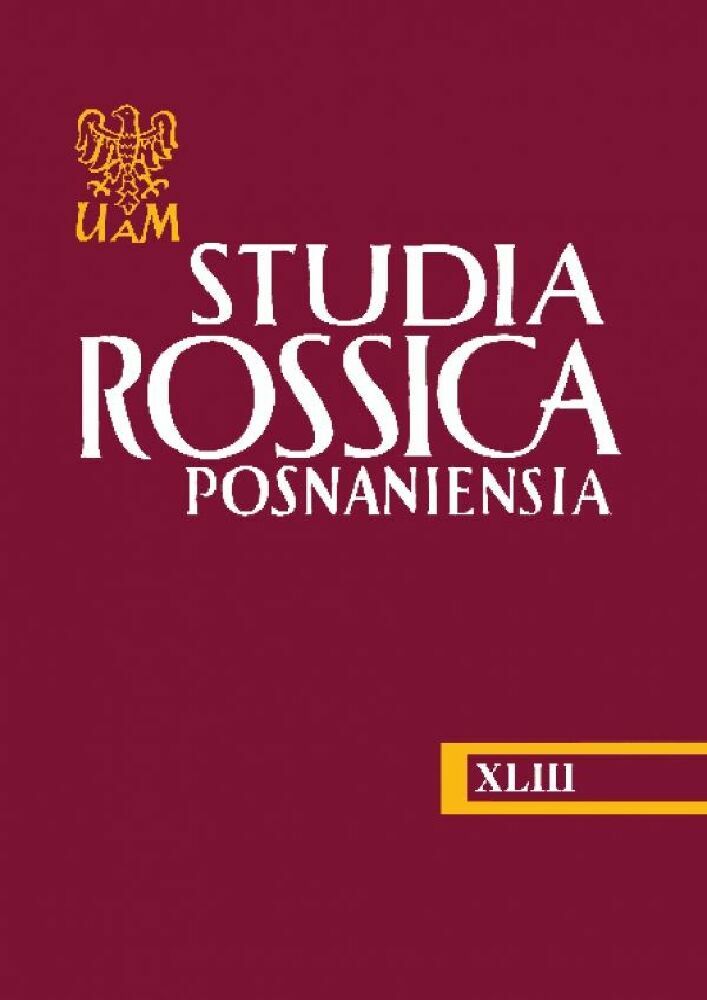Abstract
The aim of the article is to present the names of the valuables in testaments of the Russian great and appanage princes of the 14th-16th century. Special attention has been paid to clothing terminology (names of textiles, colours and dyes, individual garments, clothing details). Lexicographical and etymological data, as well as a semantic classification of dress and clothing detail names are provided. According to Jean Baudrillard, far from the primary status of an object being a pragmatic one, it is the sign exchange value which is fundamental. Thereupon, the attempt to present the social meaning and the unconscious discourse of the valuables mentioned in the testaments of the Rurik dynasty members is also made in this article.Literaturhinweise
Добродомов И. Г. 2008. Древнерусский гапакс „капторга” в лексикографическом и этимологическом освещении, „Вестник Православного Свято-Тихоновского гуманитарного университета. Сер. III: Филология”, вып. 1 (11), с. 18–26.
Толстая С. М. 2004. Одежда, [в:] Славянские древности. Этнолингвистический словарь в пяти томах, т. 3. Oтв. ред. Н. И. Толстой, Москва: Международные отношения, c. 523–533.
Barański J. 2007. Świat rzeczy. Zarys antropologiczny, Kraków: Wydawnictwo Uniwersytetu Jagiellońskiego.
Barthes R. 2006. The Language of Fashion. Translated by A. Stafford, Oxford–New York: Berg.
Bartkiewicz M. 1979. Polski ubiór do 1864 roku, Wrocław–Warszawa–Kraków–Gdańsk: Zakład Narodowy imienia Ossolińskich, Wydawnictwo.
Baudrillard J. 1968. Le système des objets, Paris: Denoël/Gonthier.
Baudrillard J. 1981. For a Critique of the Political Economy of the Sign. Translated with an Introduction by Ch. Levin, Candor (NY) USA: Telos Press Ltd.
Bogatyriew P. 1975. Funkcje stroju ludowego na obszarze morawskosłowackim, [в:] Eго же, Semiotyka kultury ludowej. Wstęp, wybór i opracowanie M. R. Mayenowa, Warszawa: Państwowy Instytut Wydawniczy, c. 26–96.
Borejszo M. 1990. Nazwy ubiorów w języku polskim do roku 1600, Poznań: Wydawnictwo Naukowe UAM.
Eco U. 2008. Historia piękna. Tłum. A. Kuciak, Poznań: Dom Wydawniczy REBIS.
Gutkowska - Rychlewska M. 1968. Historia ubiorów, Wrocław–Warszawa–Kraków: Zakład Narodowy imienia Ossolińskich, Wydawnictwo.
Malinowski B. 1932. Argonauts of the Western Pacific. An Account of Native Enterprise and Adventure in the Archipelagoes of Melanesian New Guinea, London: George Routledge & Sons, Ltd., New York: E. P. Dutton & Co.
Możdżyńska-Nawotka M. 2002. O modach i strojach, Wrocław: Wydawnictwo Dolnośląskie.
Paniuszkin W. 2013. Rublowka. Tłum. A. Sowińska, Warszawa: Agora SA.
Veblen T. 2008. Teoria klasy próżniaczej. Tłum. J. Frenzel-Zagórska, Warszawa: Warszawskie Wydawnictwo Literackie MUZA SA.
Wojtyła-Świeżowska M. 2002. O słowiańskim odziewaniu się, [в:] Dzieje Słowian w świetle leksyki. Ред. J. Rusek, W. Boryś, L. Bednarczuk, Kraków: Wydawnictwo Uniwersytetu Jagiellońskiego, c. 231–238.
Lizenz
Die Veröffentlichung von Texten geschieht in Übereinstimmung mit der Creative-Commons-Lizenz:
Namensnennung-Nicht kommerziell-Share Alike 4.0 International - Creative Commons

